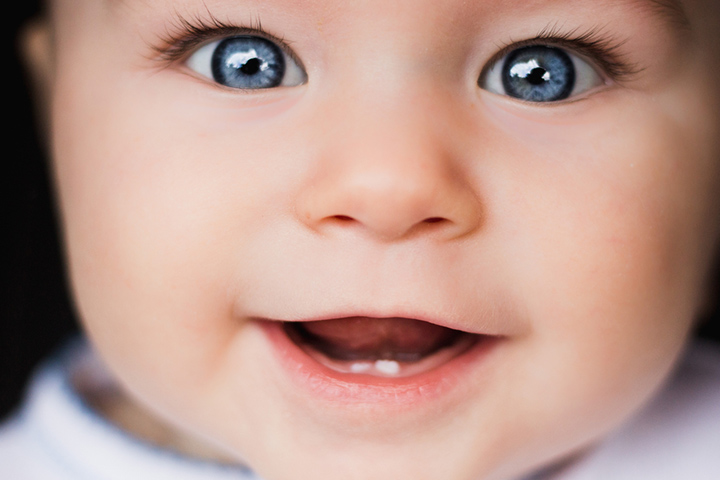
Image: Shutterstock
There is something about a baby’s sparkly eyes that can mesmerize you and make you swoon without batting an eyelid. Those gorgeously tinted eyes may make you wonder how they got it from you, specially because your eye color is way different from theirs. The fun fact is that before the end of the first year, your baby’s eye color will shift. Yes, we know how that sounds. The eye color can darken, turn green, go hazel, or even turn brown! Melanin, a pigment that defines eye color, rises throughout the first year of life, which explains why pigment darkening occurs. Although a person’s eye color may be inferred from their parents, that’s not always the case. A kid can be born with blue or green eyes, even if both mothers have brown eyes. These traits can be passed on across generations if both parents are carriers of the recessive gene. Here in this article is all you need to know about eye color and how it changes for your newborn.
How Eyes Get Their Color
It has been observed that adults with darker skin tones mostly have dark eyes (1), and light-eyed adults tend to have lighter skin tones (2). Though there is less data on baby eye color, the same theory holds. According to research conducted in 2016, most newborns with lighter skin tones had bluish-gray eyes, whereas the majority of a newborn in Equatorial regions of Pacific Islander, Native Hawaiian, & Asian infants have dark brown eyes (3). The iris contains color-producing cells. Therefore, its hue can shift once the baby’s eyes are exposed to light outside the womb (4). It takes an average of six months to form the final hue. Nonetheless, occasionally eye color keeps changing up to the age of 6. Only 10% of light-skinned infants maintain their birth-day eye color until adulthood (5). Here are some factors responsible for the eye color of your child.
1. Melanin
Image: Shutterstock
Melanocytes release the protein melanin, in your body (6). The pigment melanin determines the hue of our skin, hair, and eyes. These cells react to light throughout the first year of life by increasing melanin synthesis. As a result, your newborn’s eye color may gradually alter after delivery depending on the amount of melanin released. For example, you can attribute your baby’s blue eyes to its melanocytes only secreting a small amount of melanin. On the other hand, melanocytes produce a lot of melanin if your kid has brown eyes.
2. Genetics
Image: Shutterstock
Although OCA2 and HERC2 alleles account for the vast majority of eye color variations, about as many as 16 distinct genes are involved in the process (6). Four genes determine whether an eye is brown, blue, green, or hazel. For a long time, people believed that brown eye color was the “dominant” feature and that blue eye color was the “recessive” trait. However, modern research has shown that more than a few genes have a role in dictating an individual’s eye color (7). The precise shade of your child’s eyes will be determined by the 16 genes they receive from both you and your partner. This explains why, while rare, a child can be born to parents who both have brown eyes and have a kid with blue eyes.
Characteristics Your Newborn Will Have Because of Your Genes
Differences In Eye Color
Image: Shutterstock
Iris coloration anomalies can occur before birth. Heterochromia is a disorder that usually manifests at birth. There are often no adverse effects from it (8). However, heterochromia can also develop after an injury or illness. Unexpected events in eye color can occur for various reasons, including Horner’s syndrome, which disrupts the neural route from the brain between one side of the body and the eye (9). The damaged eye often appears paler than the unaffected one. In addition, alterations in eye color are one of the symptoms of Waardenburg syndrome, a set of hereditary disorders (10). Children affected by this illness frequently have light blue eyes, one blue eye, one brown eye, or a single eye with two distinct colored parts.
Predicting Your Child’s Eye Color
Image: Shutterstock
It’s difficult to predict your baby’s eye color since so little is known about the impact of different genes in the process. However, there are a few probabilities to keep in mind. A newborn born to parents with blue eyes has a good chance of having blue eyes. Two brown-eyed parents are more likely to produce a child with brown eyes, but there is still a potential for a kid to be born with a different eye color if one or perhaps both parents have relatives with blue, lighter-shade eyes. The family had one set of blue eyes and one set of brown eyes. The odds of the infant being born with blue eyes are almost equal to those of having brown eyes.
People with light eyes are more sensitive to light since they have less melanin in their eyes. Thus, they are defenseless against the damaging effects of direct sunshine and artificial illumination. This means that parents need to keep a close check on their children when they are playing outside. So, what color eyes do you think your child will have? Let us know in the comments section.
















